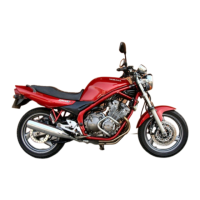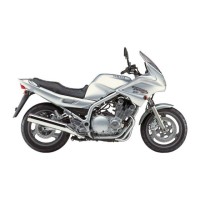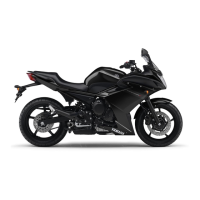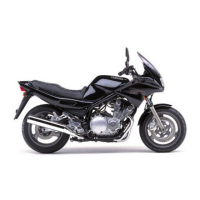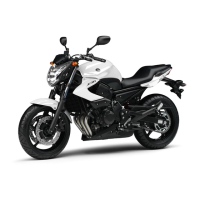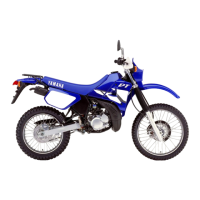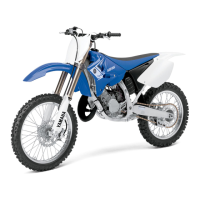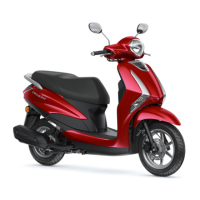Do you have a question about the Yamaha DIVERSION XJ6S 2012 and is the answer not in the manual?
Explains symbols like WARNING, NOTICE, and TIP for important information.
Emphasizes owner's duty and crucial safe riding practices.
Details essential protective gear for rider safety.
Warns about CO hazards and provides cargo loading guidelines.
Discusses risks of aftermarket parts and recommends genuine accessories.
Provides instructions for safely transporting the motorcycle.
Identifies components visible from the left side of the vehicle.
Identifies components visible from the right side of the vehicle.
Shows and names the handlebar controls and instrument cluster.
Explains the anti-theft immobilizer system and key usage.
Details the functions of the ignition switch and steering lock positions.
Explains the function of various dashboard indicator and warning lights.
Describes speedometer, tachometer, fuel meter, and clock functions.
Details the operation of switches on both left and right handlebars.
Explains the operation and adjustment of clutch, brake levers, and pedals.
Covers fuel tank cap, fuel, and breather/overflow hoses.
Details catalytic converter, seat removal/installation.
Explains helmet holder and storage compartment usage.
Covers mirrors, shock absorber adjustment, and sidestand.
Explains the ignition circuit cut-off system functions.
Outlines checks for fuel level, lines, and hoses before riding.
Details checks for engine oil and coolant levels and leaks.
Covers front/rear brake operation, pads, and fluid levels.
Describes checks for clutch, throttle grip, and control cables.
Outlines checks for drive chain, wheels, and tires.
Covers chassis fasteners, instruments, lights, switches, and sidestand switch.
Explains the procedure and conditions for starting the motorcycle.
Details how to shift gears and its importance for control.
Provides tips for fuel efficiency and break-in procedures.
Outlines safe procedures for parking the motorcycle.
Describes the contents and purpose of the owner's tool kit.
Provides schedules for emission control and general maintenance.
Guides on how to remove and install body panels for maintenance.
Details checking, changing engine oil, and replacing the oil filter.
Explains checking and changing the coolant.
Covers air filter replacement and adjusting engine idle speed.
Details checking throttle grip, valve clearance, tires, and wheels.
Covers brake lever play, light switches, pads, and fluid.
Explains checking slack, cleaning, and lubricating the drive chain.
Details lubricating cables, levers, pedals, centerstand, sidestand, and swingarm pivots.
Covers checks for front fork, steering, and wheel bearings.
Explains battery maintenance and fuse replacement procedures.
Guides on replacing headlight, tail/brake, turn signal, and license plate bulbs.
Details removing/installing wheels and troubleshooting common issues.
Provides flowcharts for diagnosing starting and performance issues.
Explains how to handle engine overheating and radiator cap procedures.
Advises on cleaning and maintaining matte finished parts.
Provides comprehensive instructions for cleaning the motorcycle.
Offers guidance for short-term and long-term storage of the motorcycle.
Lists physical dimensions and engine details of the motorcycle.
Details fuel type, injection system, and spark plug specifications.
Provides specifications for clutch, transmission, frame, and suspension.
Lists tire sizes, wheel types, and brake system details.
Details charging system, battery, headlight, and fuses.
Explains how to record vehicle and model identification numbers.
Explains symbols like WARNING, NOTICE, and TIP for important information.
Emphasizes owner's duty and crucial safe riding practices.
Details essential protective gear for rider safety.
Warns about CO hazards and provides cargo loading guidelines.
Discusses risks of aftermarket parts and recommends genuine accessories.
Provides instructions for safely transporting the motorcycle.
Identifies components visible from the left side of the vehicle.
Identifies components visible from the right side of the vehicle.
Shows and names the handlebar controls and instrument cluster.
Explains the anti-theft immobilizer system and key usage.
Details the functions of the ignition switch and steering lock positions.
Explains the function of various dashboard indicator and warning lights.
Describes speedometer, tachometer, fuel meter, and clock functions.
Details the operation of switches on both left and right handlebars.
Explains the operation and adjustment of clutch, brake levers, and pedals.
Covers fuel tank cap, fuel, and breather/overflow hoses.
Details catalytic converter, seat removal/installation.
Explains helmet holder and storage compartment usage.
Covers mirrors, shock absorber adjustment, and sidestand.
Explains the ignition circuit cut-off system functions.
Outlines checks for fuel level, lines, and hoses before riding.
Details checks for engine oil and coolant levels and leaks.
Covers front/rear brake operation, pads, and fluid levels.
Describes checks for clutch, throttle grip, and control cables.
Outlines checks for drive chain, wheels, and tires.
Covers chassis fasteners, instruments, lights, switches, and sidestand switch.
Explains the procedure and conditions for starting the motorcycle.
Details how to shift gears and its importance for control.
Provides tips for fuel efficiency and break-in procedures.
Outlines safe procedures for parking the motorcycle.
Describes the contents and purpose of the owner's tool kit.
Provides schedules for emission control and general maintenance.
Guides on how to remove and install body panels for maintenance.
Details checking, changing engine oil, and replacing the oil filter.
Explains checking and changing the coolant.
Covers air filter replacement and adjusting engine idle speed.
Details checking throttle grip, valve clearance, tires, and wheels.
Covers brake lever play, light switches, pads, and fluid.
Explains checking slack, cleaning, and lubricating the drive chain.
Details lubricating cables, levers, pedals, centerstand, sidestand, and swingarm pivots.
Covers checks for front fork, steering, and wheel bearings.
Explains battery maintenance and fuse replacement procedures.
Guides on replacing headlight, tail/brake, turn signal, and license plate bulbs.
Details removing/installing wheels and troubleshooting common issues.
Provides flowcharts for diagnosing starting and performance issues.
Explains how to handle engine overheating and radiator cap procedures.
Advises on cleaning and maintaining matte finished parts.
Provides comprehensive instructions for cleaning the motorcycle.
Offers guidance for short-term and long-term storage of the motorcycle.
Lists physical dimensions and engine details of the motorcycle.
Details fuel type, injection system, and spark plug specifications.
Provides specifications for clutch, transmission, frame, and suspension.
Lists tire sizes, wheel types, and brake system details.
Details charging system, battery, headlight, and fuses.
Explains how to record vehicle and model identification numbers.
| Displacement | 600cc |
|---|---|
| Bore x Stroke | 65.5 mm x 44.5 mm |
| Compression Ratio | 12.2 : 1 |
| Lubrication System | Wet sump |
| Ignition System | TCI |
| Starter System | Electric |
| Transmission | 6-speed |
| Final Transmission | Chain |
| Frame | Diamond |
| Front Suspension System | Telescopic fork |
| Front Travel | 130 mm |
| Rear Suspension System | Swingarm |
| Front Tyre | 120/70 ZR17M/C (58W) |
| Rear Tyre | 160/60 ZR17M/C (69W) |
| Overall Length | 2, 120 mm |
| Overall Width | 770 mm |
| Seat Height | 785 mm |
| Wheel Base | 1, 440 mm |
| Minimum Ground Clearance | 140 mm |
| Fuel Tank Capacity | 17.3 litres |
| Oil Tank Capacity | 3.4 litres |
| Engine Type | Liquid-cooled, 4-stroke, DOHC, 4-valve |
| Maximum Power | 77.5hp (57.0kW) @ 10, 000rpm |
| Clutch Type | Wet, multi-disc |
| Front Brake | Dual hydraulic discs, Ø 298 mm |
| Rear Brake | Hydraulic disc, Ø 245 mm |

